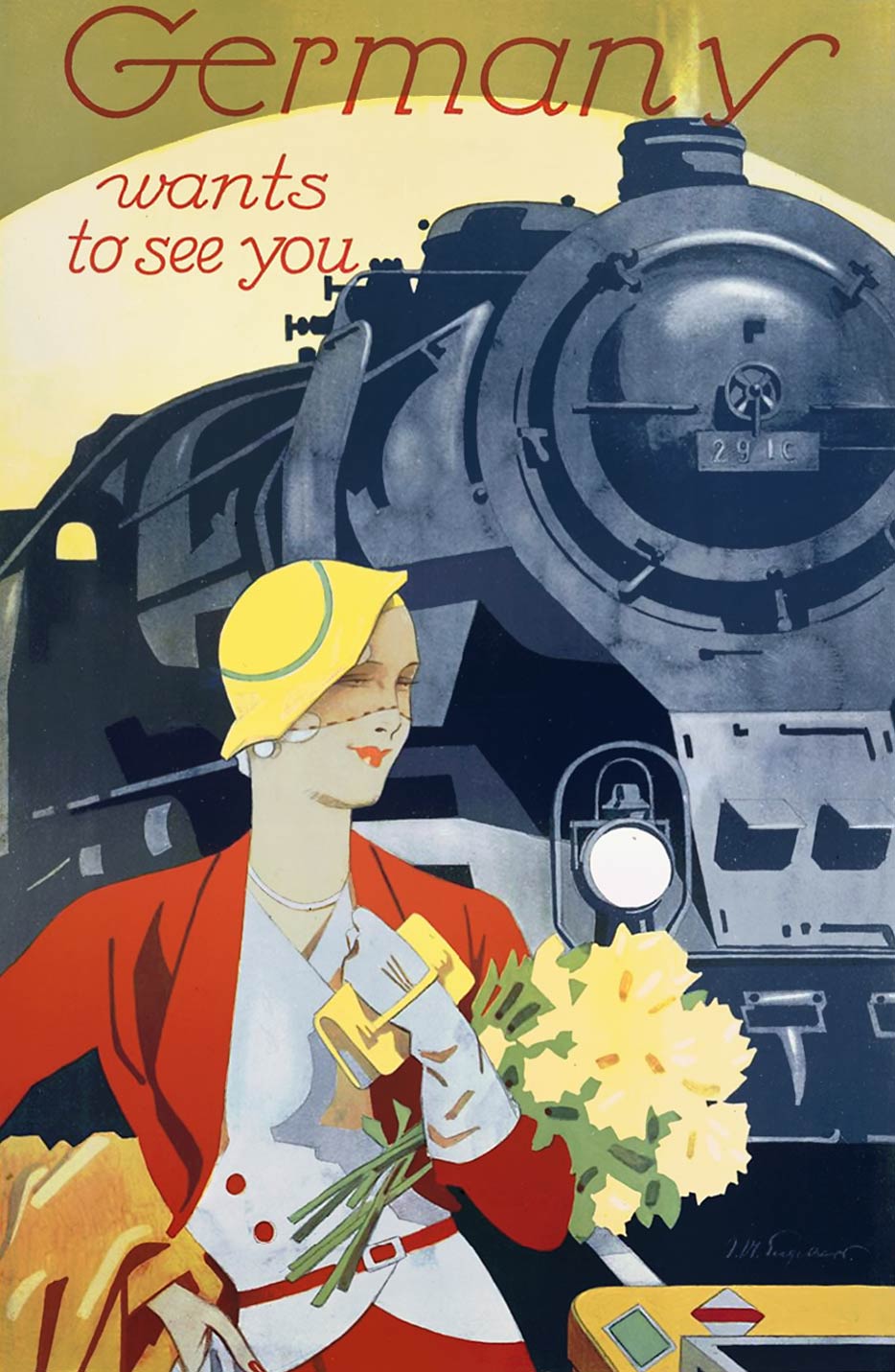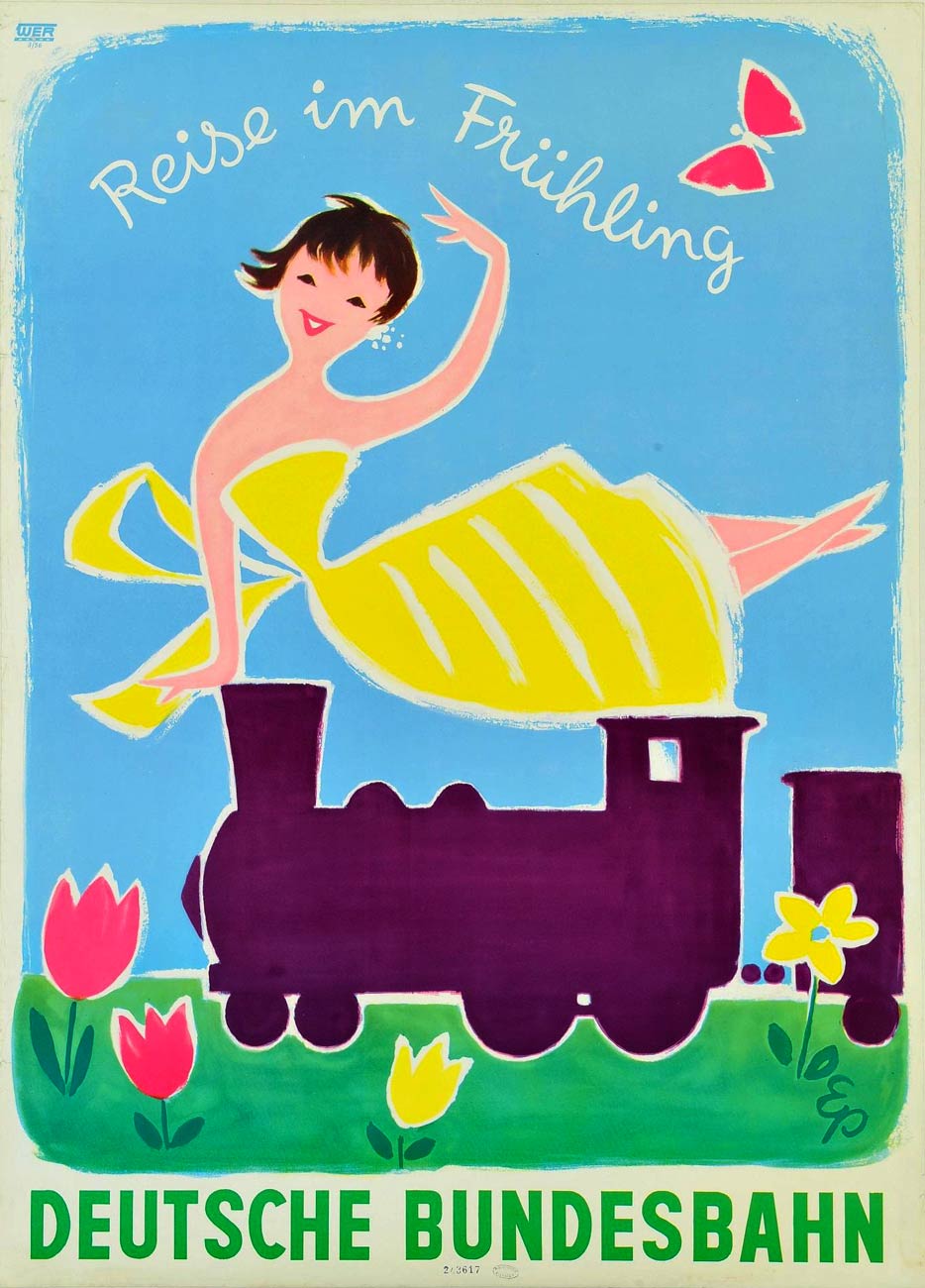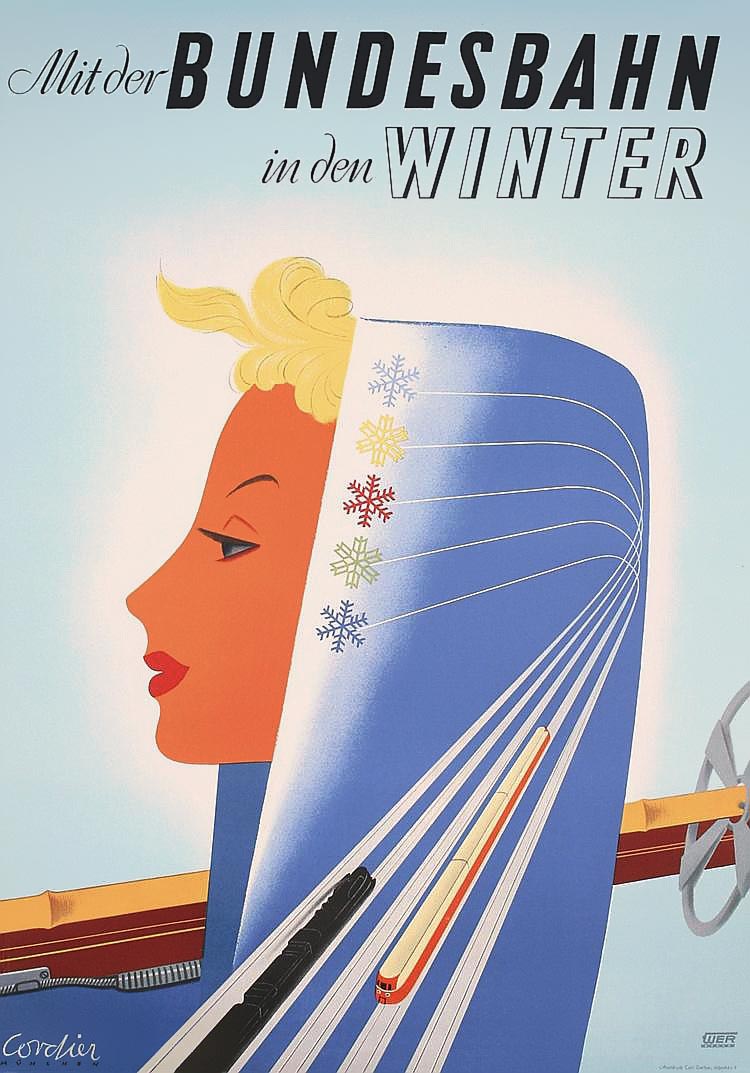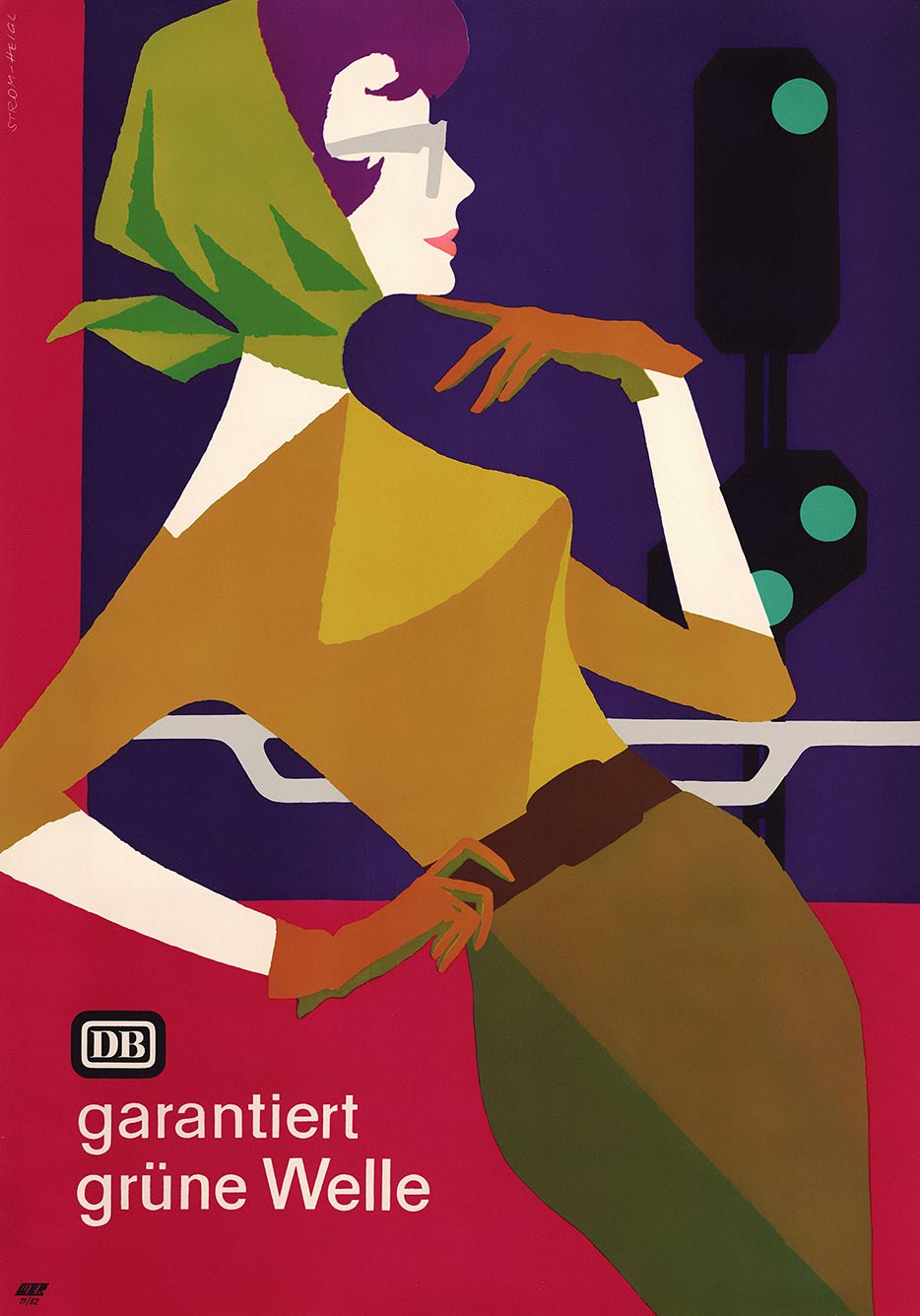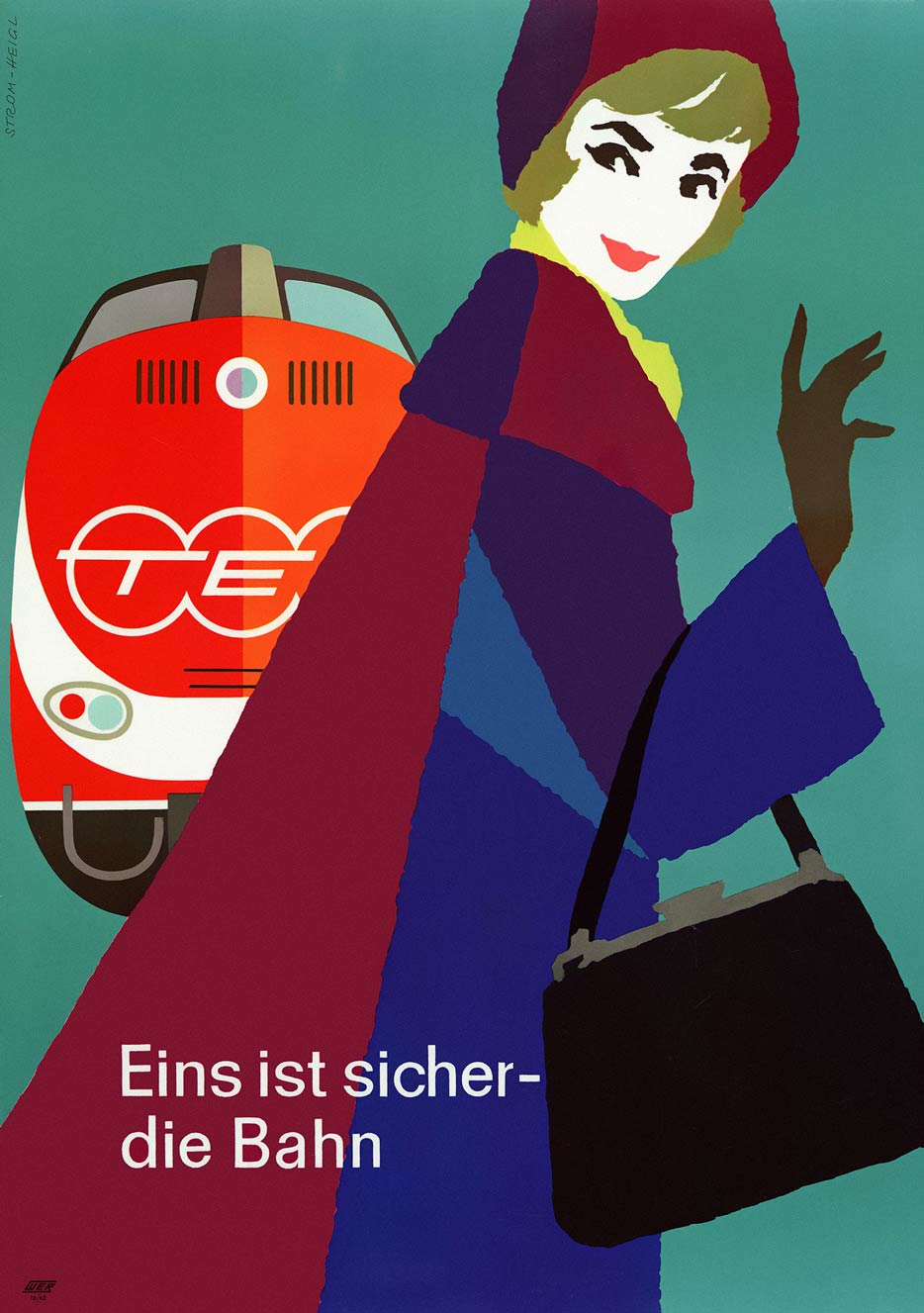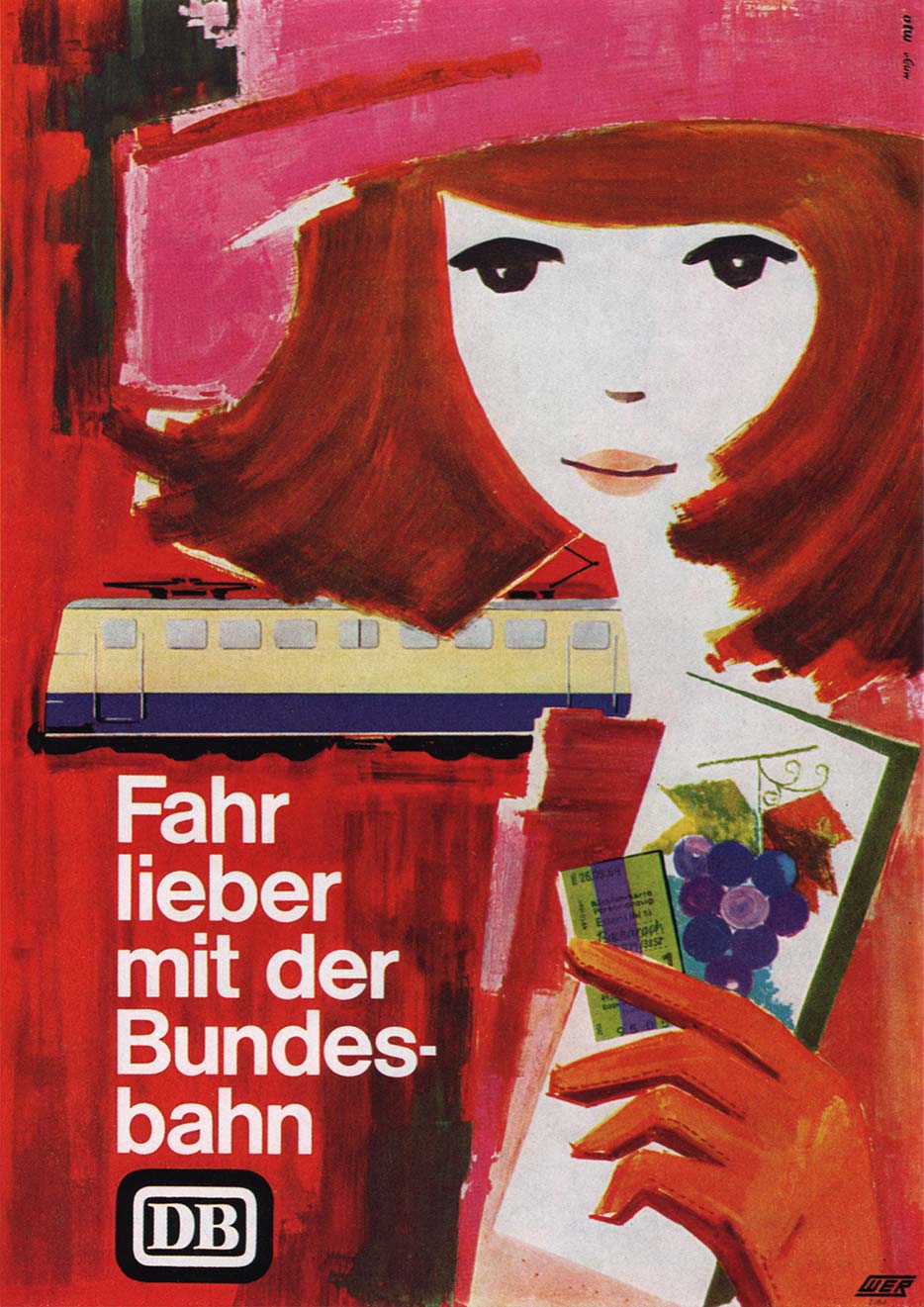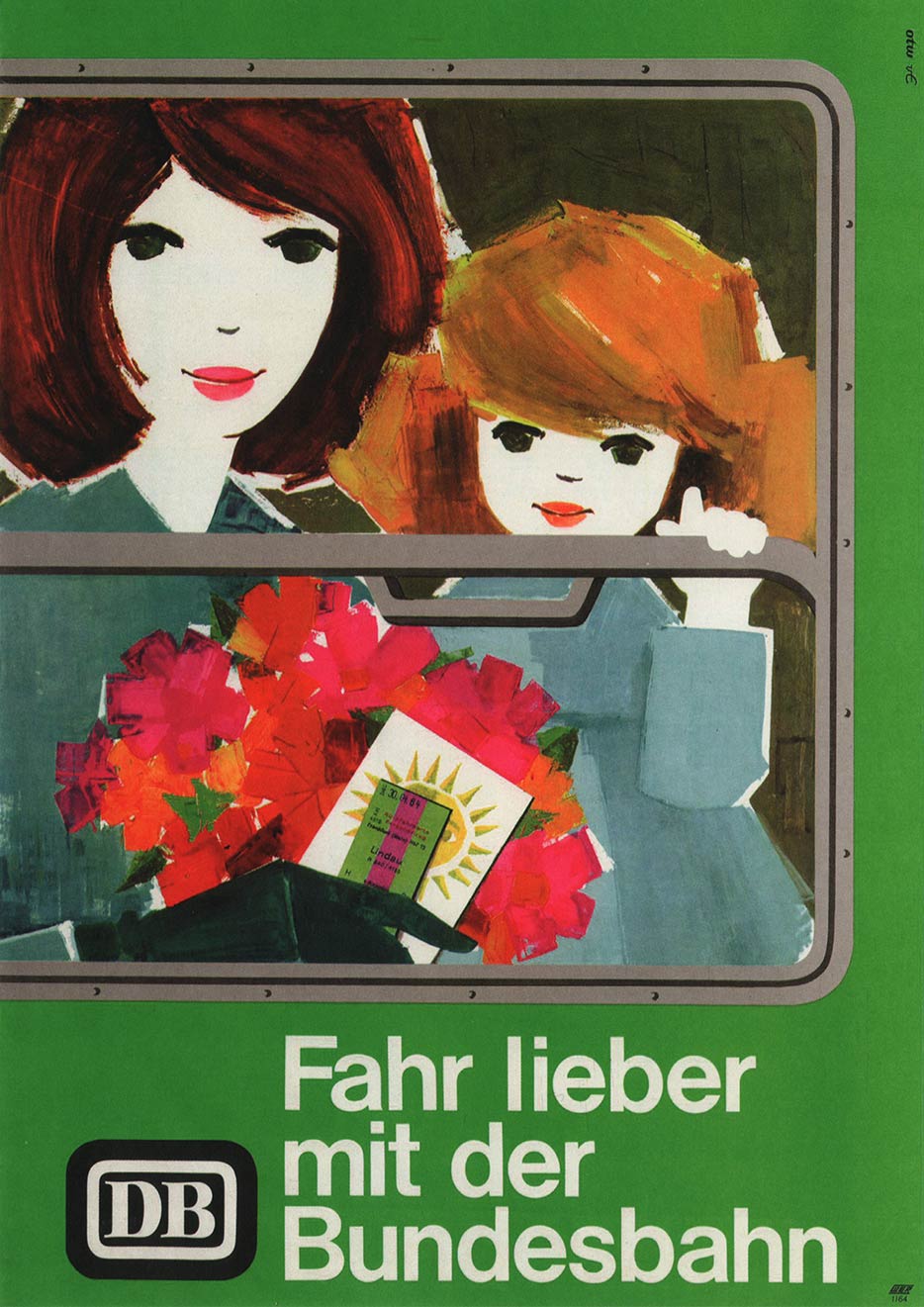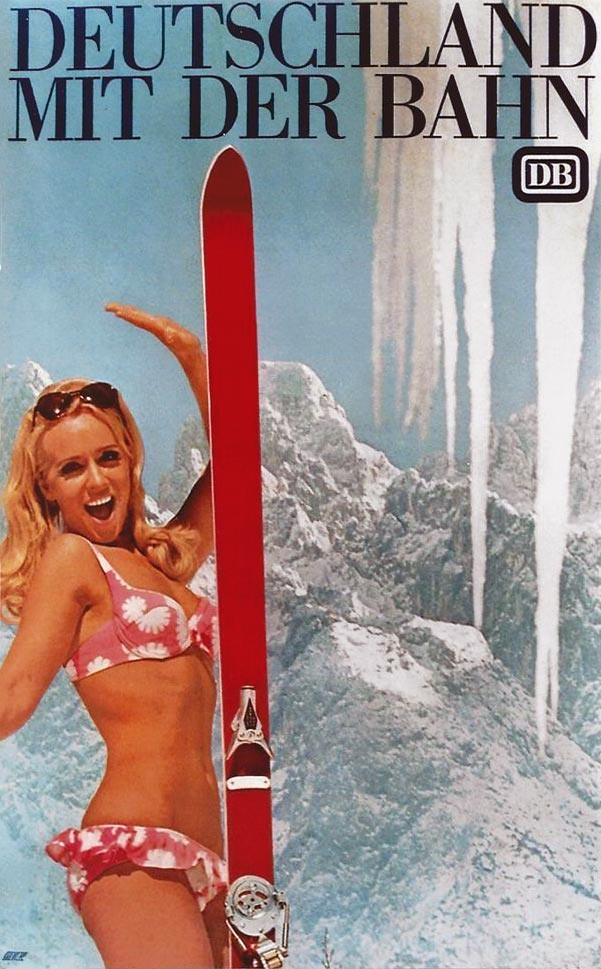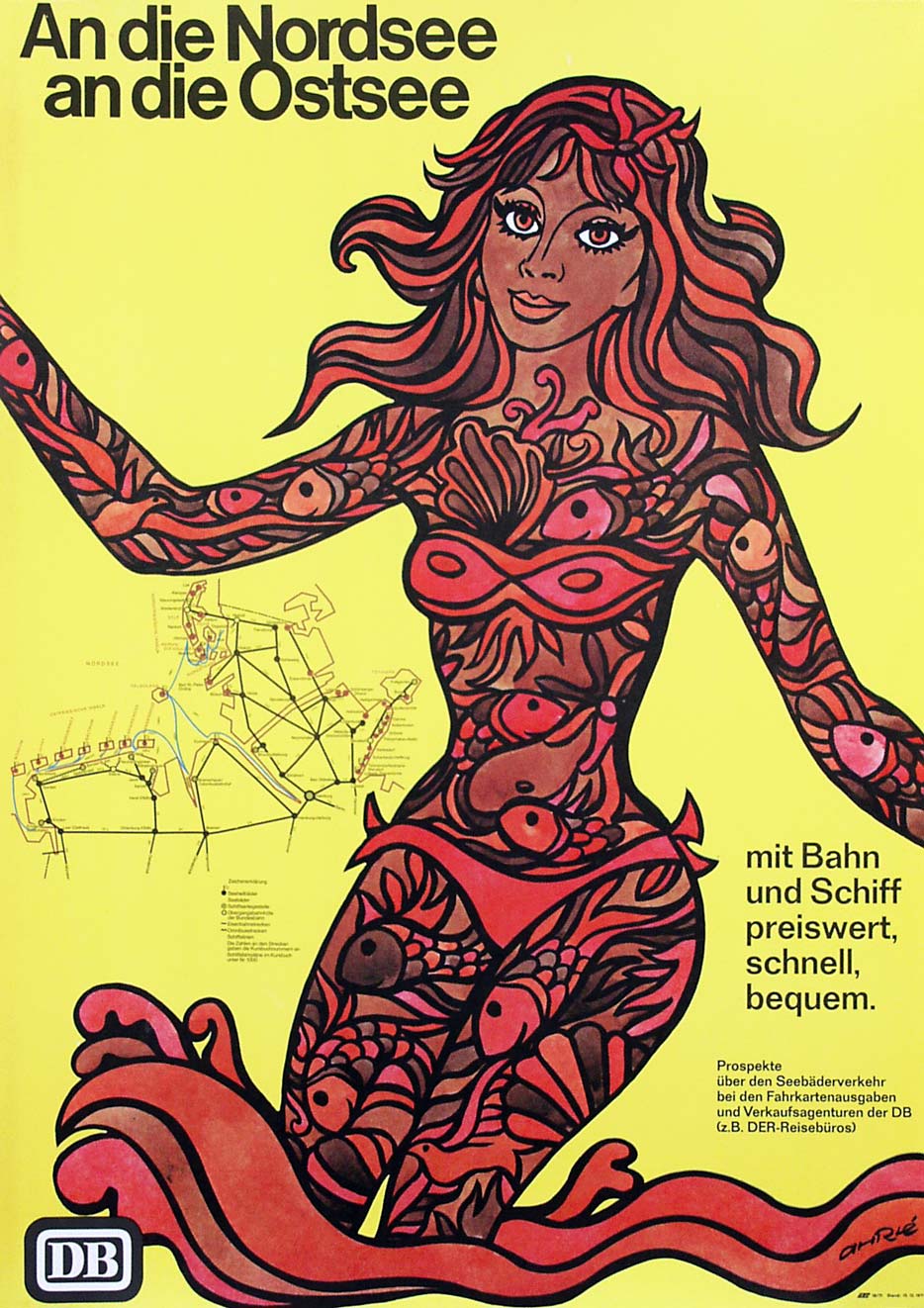Frauenplakatserien
Women posters of the German Federal Railway
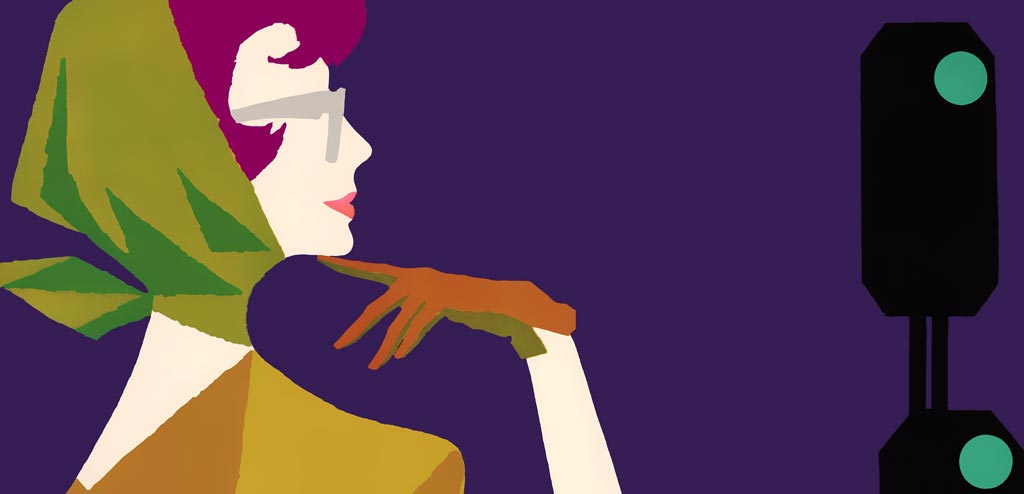 Nederlandse versie
Nederlandse versie
During most of the 20th century the railways and advertising industries were a man's world. By conducting market research the Werbeambt (advertising agency) of the German railway found out that women were an important target audience.
Special series of Frauenplakate (women posters) were designed with, for and partly by females. The image of women on railway posters changed with the times: from elegant via dependent to liberated — or still as sex objects?
Before World War II
Already around 1930 the German Reichsbahn published posters depicting women. This was not obvious, given the association of railways with technology and the common gender roles of the period. The 1927 poster Germany wants to see you by Julius Ussy Engelhard targeted foreign tourists. An elegant German lady posed in front of a steam locomotive with a flower bouquet. Did she primarily serve as a teaser for men, or did the railways want to appeal to a female audience? The latter seems to be the case on the poster titled Die bequeme Eisenbahnreise by Hein Neuner of 1937.
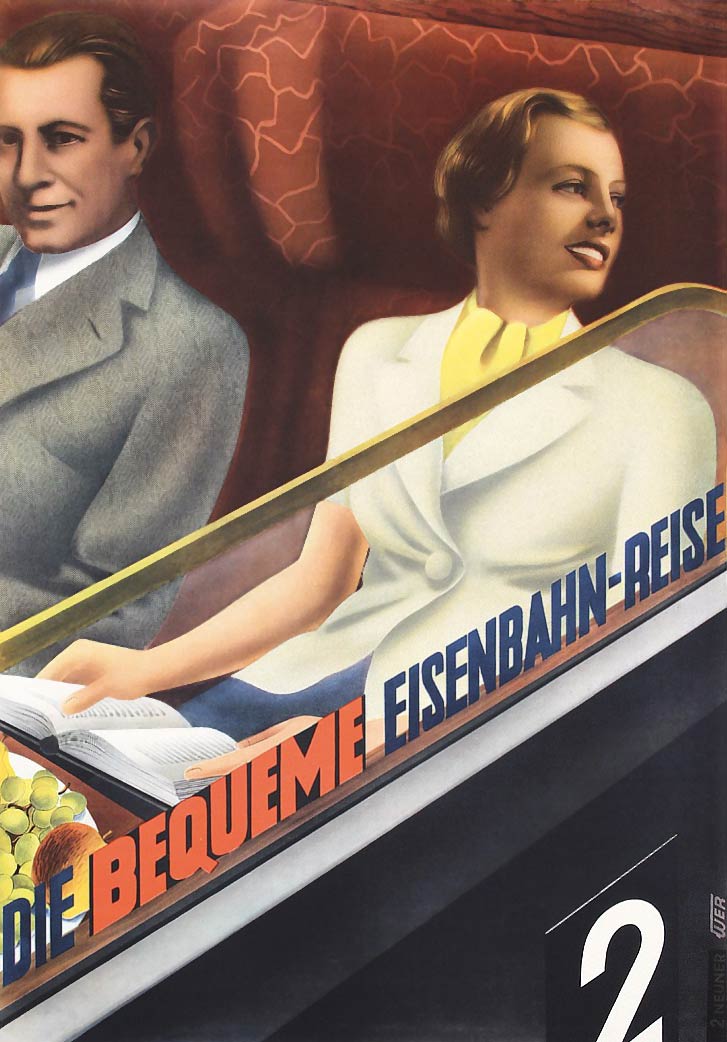
Neuner's poster was published by the WER, the Reichsbahn-Werbeamt für den Personen- und Güterverkehr. This centralized advertising agency for the German railways was responsible for all posters and brochures from 1934 onwards. Although founded in the Hitler era, this organization was not directly involved with Nazi propaganda and would survive the Second World War — in contrast to its parent company, the Reichsbahn (at least in West Germany).
The early Bundesbahn
Immediately after World War II the Reichsbahn was under control of the British and American occupiers. Following the founding of the Bundesrepublik Deutschland in 1949 the railways were rebranded as Deutsche Bundesbahn. In West Germany this was the successor to the Reichsbahn, which kept its old name in the GDR. In the west the pre-war rail advertising agency WER continued to exist, now called the Bundesbahn Werbe- und Auskunftsamt für den Personen- und Güterverkehr in full. During a long period Werner Walz was its director.

Women rarely travel alone, and have little influence on the choice of transportation, was the assumption of the time. They only received incidental attention in railway advertising. The 1954 Unser Verkehrsmittel poster pictured a woman surrounded by men at a station. In 1958 she was given an autonomous role on the poster with the neutral title Man fährt mit der Deutschen Bundesbahn (literally: One travels with the DB). Both posters were designed by Atelier Grave-Schmandt, an agency founded in Frankfurt in the early 1950s by Hans Schmandt (1920-1993) and Heinz Grave (details unknown). Besides railway posters they also created book illustrations and murals.
Female designers
Both the railways and the advertising industries were male bastions in the 1950s and 60s. Nevertheless the WER hired at least five female designers during these decades. This did not happen in the surrounding countries, from which no women's railway posters are actually known from this period (except for the United Kingdom). In addition to the female half of the Nierhaus + Estenfelder duo (see below), artist Eva Höfner-Pönicke was one of the women designing for the Bundesbahn. Her spring poster Reise im Frühling (1956) shows a bright and lightly dressed woman as a counterpart to a dark steam engine.

A 1958 summer holiday poster by Erika Müller, whose details are unknown, was distributed throughout Europe in multiple languages. However, many thought the painting style was "too bold" and the poster was "incomprehensibly not comprehended abroad", according to WER director Walz. The purple horse reminds of the expressionism of Der Blaue Reiter half a century before. A VT11.5 TEE trainset, the Bundesbahn's 'parade horse', runs over the viaduct.
Our advertising agency only employs freelance designers; we do not have our own design studio. These graphic artists include not only renowned names, such as Andrian, Schmandt or Stiller. Gifted young designers will always get a chance at the WER. One day, for example, a girl who looked half-starved announced herself.
The young lady had been fired by her former employer because she had produced designs that were too avant-garde. She was given a test assignment and promptly turned it into a good poster. This story, as touching as it may sound, does carry real significance. A young designer who worked for the Bundesbahn will also get assignments elsewhere.
Women and winter sports
Germany's first ski lift was opened in 1948 in the Bavarian village of Sudelfeld. In the 1950s and 60s winter sports became a mass activity. Besides technical innovations of equipment (better skis, boots, ties and ski clothing) a tourist infrastructure of slopes, ski lifts, cable cars, ski huts and hotels was established. Mountain areas were made accessible by new roads, but despite increasing car traffic, trains remained important for reliable long-distance transport.

Winter sports posters of the Deutsche Bundesbahn frequently featured women, a sign that skiing was widely practiced by both sexes. Eugene Maria Cordier pictured an idealized woman on his 1952 poster Mit der Bundesbahn in den Winter: a kind of Madonna, albeit with skis on her shoulders and trains on her headdress. Autodidactic illustrator Heinz Schwabe drew a more everyday woman on Zum Wintersport mit der Bundesbahn (1957), even though he indicated her face only sketchily. Her skis are sticking through the train window.
The first Frauenplakatserie
While earlier posters with women were more or less coincidental, from 1962 onwards there was a policy behind them. As one of the first German advertising agencies the WER conducted large-scale market research. This showed that "the influence of women on the choice of transportation is decisive for family trips. Also, as solo travelers, women generally prefer the train."
Consequently the first Frauenplakatserie was conceived: a series of three posters aiming at women and depicting elegant ladies, designed by Atelier Strom-Heigl. Artist Ernst Strom (1929) had founded this agency around 1960 in Munich with illustrator Max Heigl (details unknown). Their posters were among the best of Germany in the 1960s, featuring simplified shapes, powerful colors and a touch of humor when appropriate.
The texts on the three posters, not specifically related to women, were the result of a slogan competition within the WER. Mit Pfiff per Bahn can be translated as Smart by rail, but also refers to the conductor's whistle. The 'green wave' of Garantiert grüne Welle was made visible by signals in the background. Eins ist sicher, die Bahn was about the reliability of railways in all weather conditions.
The human side of the railways was central on the women posters, which didn't mean no rolling stock was pictured at all. But trains were made subordinate to people by depicting them relatively small. On the background of Mit Pfiff by Bahn we can see the Bundesbahn's V200 diesel locomotive, used extensively for passenger and freight transport from 1956 onwards. On Eins ist sicher, die Bahn the distinctive round front of a VT11.5 Trans Europ Express trainset is visible.
Passenger traffic continues to grow on the West German Bundesbahn, according to the director of the Bundesbahn Werbe- und Auskunftsamt, Dr. Werner Walz. On the one hand advertising must be aimed at raising trust and convince potential travelers that they will be transported in a safe, quick and inexpensive way. On the other hand commercial advertising should focus on the more expensive travel options such as the TEE trains, and should not forget about the influence of women on the final transport decision.
But how does modern advertising work? This question not only concerns the implementation, but also the method. To find this out we need to know the people and their wishes, thoughts and, if possible, even the structure of their subconscious minds from which their wishes and motives emanate. These issues have been investigated by advertising science. The progress made in this field, as well as improvement in market research and analysis, serve as the basis for railway advertising in West Germany.
The second Frauenplakatserie
In the autumn of 1964 the WER commissioned another series of women posters, this time under the motto Fahr lieber mit der Bundesbahn. The first poster series was for women and with women, but made by men. The second series was created by a female artist: Marianne von Euw.
She worked for the large advertising agency OTW (Operationales Team für Werbekommunikation) of Paul Ohlert in Berlin. Nothing more is known about Von Euw, apart from the fact that one of her women posters won a prize as exemplary large poster of the year 1964.
The artist being a woman did not mean stereotypes were avoided. The 'lady with grapes' (named after the leaflet in her hand) has a young, almost childlike face with very big eyes and a delicate mouth. In the background is an E10 Rheingold locomotive (matching the Rhine Valley vines on the leaflet). Another poster from this series shows a mother and daughter in an open train window — a common motive — with a flower bouquet. In both cases the women are carrying a travel leaflet and their train ticket like a trophy.
The seventies
The sexual revolution of the late 1960s dramatically changed the way women were portrayed on railway posters. Strikingly often they were shown in bikini. This can be considered an abuse of women's bodies as sex objects for commercial gain, or on the other hand as a symbol of women's acquired freedoms. In the latter view partly naked women can represent a feeling of freedom and holiday atmosphere that fits well with the railways.
A tasteful example is a poster for train trips to the North Sea and Baltic Sea by René Ahrlé from 1971. The woman's body is graphically composed of fishes, possibly referring to mermaids. But combined with the rise of color photography on posters in the same decade, associations with cheap men's magazines are not far-fetched, as the 1970 poster Deutschland met der Bahn shows.
